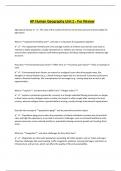AP Human Geography Unit 2 - For Review
Agricultural density ✔️✔️The ratio of the number of farmers to the total amount of land suitable for
agriculture
What is **replacement fertility rate**, and why is it important for population stability?
✔️✔️ The replacement fertility rate is the average number of children each woman must have to
maintain a stable population, usually estimated at 2.1 children per woman. It’s important because it
ensures that a population replaces itself without growing or shrinking, helping maintain a balanced age
structure.
How does **environmental push factor** differ from an **economic push factor**? Give an example of
each.
✔️✔️ Environmental push factors are natural or ecological issues that drive people away, like
droughts or natural disasters (e.g., a family leaving a region due to a hurricane). Economic push factors
relate to financial hardships, like unemployment or low wages (e.g., moving away due to lack of job
opportunities).
What is **asylum**, and how does it differ from **refugee status**?
✔️✔️ Asylum is protection granted by a country to a foreign individual fleeing persecution or danger
in their home country. Refugee status is similar, but asylum is often sought after arriving in the host
country, whereas refugee status is granted before arriving, usually through international organizations.
Describe the concept of **population aging** and its potential economic impact.
✔️✔️ Population aging occurs when the proportion of elderly individuals increases due to low birth
rates and high life expectancy. It can lead to economic challenges, such as increased healthcare costs,
pension pressures, and a reduced workforce, potentially slowing economic growth and creating fiscal
strain.
What are **megacities**, and what challenges do they often face?
✔️✔️ Megacities are cities with populations exceeding 10 million people, such as Tokyo and Lagos.
They face challenges like overcrowding, traffic congestion, pollution, housing shortages, and strain on
infrastructure and services, which can affect the quality of life and sustainability.
, Explain **crude death rate (CDR)** and how it’s used in population studies.
✔️✔️ Crude death rate (CDR) is the number of deaths per 1,000 people in a population in a given year.
It helps measure population health and stability, providing insights into factors affecting mortality, such
as healthcare quality, living conditions, and age structure.
What is **transnational migration**, and how does it differ from internal migration?
✔️✔️ Transnational migration is the movement of people across international borders, while internal
migration is within a single country. Transnational migrants establish lives in more than one country,
often maintaining connections with both their origin and destination countries, affecting cultural
exchange and economies.
Define **dependency ratio** and explain its impact on society.
✔️✔️ The dependency ratio is the ratio of non-working (young and elderly) to working-age people. A
high dependency ratio can strain resources, as fewer workers must support dependents, affecting
economic productivity, healthcare, education, and social services.
What is **chain migration**, and how does it influence settlement patterns?
✔️✔️ Chain migration is when individuals migrate to a new location based on family or community
ties, following friends or relatives who have already moved. It leads to clustered settlement patterns,
where communities from the same origin often live in close proximity, creating cultural enclaves.
How does **life expectancy** differ between developing and developed countries?
✔️✔️ Life expectancy is generally lower in developing countries due to limited access to healthcare,
lower living standards, and poorer nutrition. In developed countries, life expectancy is higher, with
better healthcare, higher standards of living, and advanced medical care.
What is **graying population**, and why is it significant in developed countries?
✔️✔️ A graying population refers to an increasing number of elderly individuals in a population. In
developed countries, this trend is significant because it raises healthcare and pension costs and can lead
to labor shortages, impacting economic growth and social services.
Explain the role of **fertility rate** in determining future population trends.




